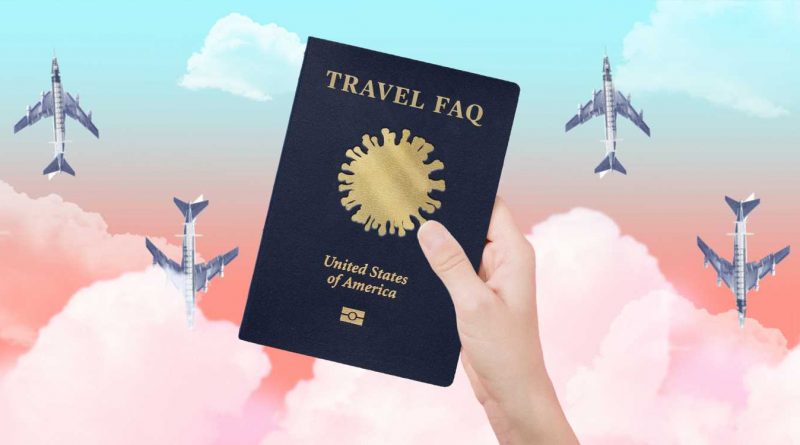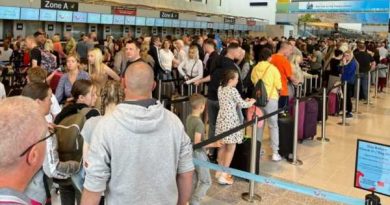Is flying safe now? Answers to your burning COVID-19 travel questions
It’s been over a year since the World Health Organization named COVID-19, the disease caused by the new coronavirus, a global pandemic — a year largely defined by people staying put in their homes, cities and countries alike.
Load Error
But now, with widespread vaccinations on the horizon and ever-building pandemic fatigue, it appears that Americans are itching to travel again. Last week, the Transportation Security Administration reported the highest number of air travelers — 1,357,111 — since March 15, 2020. And according to an Airbnb report released in January, 54% of those surveyed have either booked travel, are planning to travel or expect to travel in 2021.
“I think it’s going to become more and more of an acceptable risk for people,” Dr. Amesh Adalja, a senior scholar at the Johns Hopkins Center for Health Security and an infectious disease physician, told TODAY over Zoom. “What I’m speaking about is the way that people are going to psychologically approach this — not that there’s no risk involved.”
According to Adalja, some degree of risk will persist until America reaches herd immunity, aka when the majority of citizens are immune to the coronavirus through vaccination and prior infection. At the same time, more travel seems inevitable — so here are answers to all your burning questions about the state of travel right now.
Can I travel after I get the COVID-19 vaccine?
If you’ve received two doses of the Pfizer or Moderna vaccine, you’ll be 94% and 95% less likely to get seriously sick, Dr. Chris Beyer, a professor of epidemiology at the Johns Hopkins Bloomberg School of Public Health, told TODAY back in January. Adalja said that the Johnson & Johnson vaccine is also a sound choice — while reported to be 72% effective, it’s 100% effective at preventing hospitalization and death, and you can’t meaningfully compare efficacy rates across vastly different clinical trials that took place at different inflection points during the pandemic.
Still, Beyer emphasized the distinction between being protected from the virus and being able to protect your community from the virus.
“It is certainly going to be safer to travel once you’re immunized, but on the other hand, we also do not know the answer to the question of ‘Are people who have been immunized still infectious for others?’” he explained.
While Adalja predicts that data will soon show the vaccine’s effectiveness in eliminating asymptomatic carriers, it’s best to remain cautious until that data emerges. This means continuing to practice social distancing, avoid crowded places, wash your hands and wear a high-quality mask when traveling, even if you’re fully vaccinated.
“Let’s remember there can be vaccine failures. We still don’t know for sure whether asymptomatic spread is possible in vaccinated people,” Dr. Colleen Kelley — an associate professor of infectious diseases at Emory University School of Medicine who is involved with the Moderna and Novavax vaccine clinical trials — previously told TODAY. “We need some additional data before we fully understand the implications of the vaccinated person who is in a community where widespread transmission is still going on.”
Not only do certain destinations suffer higher transmission rates, but they also might contain new and apparently more transmissible variants of the coronavirus — like the U.K., Brazil or South Africa strains. Because researchers have yet to reach a definitive conclusion on the vaccine’s effectiveness against them, their existence is another factor that could make travel risky.
The variants, while international in origin, have been found in many American states. Experts predict that others will soon emerge.
“I think this is going to be an evolving situation… I do think the news so far is positive, but we don’t know everything that we need to know yet,” said Kelley. “It’s too early to say completely, absolutely, that the vaccines are going to be effective against the variants that we’re hearing about, but I would say this early data looks good.”
For U.S. citizens, what does traveling abroad look like?
According to Airbnb’s report, the majority of those surveyed would prefer to travel domestically or locally, whereas only 21% have their eyes on an international location. This makes sense: Adalja explains that in 2021, the new variants and the differing pace of vaccination from country to country will continue to make globe-trotting difficult.
“International travel occurs now with quarantines and testing, and I think that’s going to be the case for some time until the world gets to generally the same place,” he said. “Until we get to some higher level of vaccination in the domestic population, as well as other countries’ own domestic populations — they’re still going to be pretty restrictive on who they let in.”
Related: Many Americans are reconsidering their priorities and where they want to live after a year of isolated living.
By “quarantines and testing,” Adalja refers to the myriad of restrictions and requirements that travelers must take into account. As of January, the CDC requires anyone returning to the United States by air to take a viral test (either antigen or nucleic acid amplification, aka NAAT) no more than three days before their flight and present the negative result at the time of boarding — regardless of where they’re coming from.
Moreover, most countries open to U.S. passports have their own coronavirus measures in place. Neglecting to follow them exactly can lead to a vacation that’s wasted away in quarantine. Getting the right kind of test (FYI: Most countries don’t accept antigen test results) and making sure the results come back within the right time frame is crucial.
What about traveling to Hawaii?
U.S. citizens fiending for a tropical getaway will likely look to Hawaii, which offers most of the perks but none of the logistical hassles that accompany international travel. But to prevent porous borders from causing its coronavirus numbers to skyrocket, the state has strict rules for anyone trying to enter.
I’ve navigated these waters myself having spent the past month living on the North Shore of Oahu as a college student on a gap year. To avoid a 10-day quarantine upon arrival, I had to obtain a negative NAAT test from one of the state’s Trusted Travel Partners no more than 72 hours before travel. When booking a test, be sure to triple-check the provider against that list. Even if the test is correct, airport officials won’t accept an unlisted provider, no matter how reputable.
One of my roommates learned this lesson the hard way: Despite receiving a negative test from the company spearheading Boston’s vaccination program, she still had to quarantine in our Airbnb for 10 days. She couldn’t even leave the driveway. If caught breaking quarantine, she’d face penalties of up to $5,000 and a year in prison.
Fortunately, you can avoid making the same mistake with some due diligence. While low-cost testing options at CVS and Walgreens qualify as trusted partners, they might have a longer turnaround than 72 hours, depending on where you live. At most other providers, though, you can pay to guarantee results within a certain time frame.
Chances are that your airline has made the search even easier. I flew Hawaiian Airlines, which partners with Worksite Labs to offer 36-hour test results for $90. United Airlines even provides a $119 mail-in testing option.
In addition to being tested, you’ll have to register with the state’s Safe Travels program — which requires your basic information and a negative test result submission. Afterward, you’ll get a QR code to scan at a Hawaiian airport.
Is flying safe during the COVID-19 pandemic? Will it increase my risk of contracting the virus?
While coronavirus transmission during a flight is certainly possible, Adalja emphasizes that “it’s more about what you do at your destination that gets you infected when you travel.” For example, being on a plane with a well-enforced mask policy carries a lower chance of infection than going to an indoor gathering with your friends, sans masks, or even to an indoor restaurant.
“A lot of people worry about these common-touch surfaces that are on airplanes, and it’s very clear now that the epidemiology of this infection supports a lesser role for surface transmission,” said Adalja in a previous TODAY piece on the safety of flying.
An important consideration is what steps your airline has taken to mitigate the spread. While every domestic airline requires face coverings on board and deep cleans its aircraft between flights, there are some noteworthy differences.
Now, Delta Air Lines is the only airline to limit capacity by blocking all middle seats — a policy that’s in place until March 31. Frontier, on the other hand, is the only one to take passengers’ temperatures before boarding.
Even with these measures, safety is also a collective responsibility shouldered by the passengers. Adalja said that the more contagious variants mean that “you can’t tolerate lapses in your common-sense precautions.” Such lapses include wearing a flimsy mask, not covering your nose, and eating or drinking for prolonged periods of time as an excuse to take off your mask.
“In general, I think if you’re wearing a face covering when you’re on a plane, and the airlines are strict about not allowing anybody that has any symptoms that are consistent with COVID — at least that they know of — on a plane, I think it can be done relatively safely,” Adalja said. “There have been studies that really show if people are wearing face coverings, it’s very hard to get infected on a plane.”
Do I need to quarantine if I travel by air during the COVID-19 pandemic?
Some destinations, both international and domestic, require visitors to quarantine after arrival; however, in many cases, the decision of whether to quarantine is up to the individual. While Adalja advises that returning travelers take precautions, he doesn’t think that a strict quarantine is necessary — at least, not solely based on a flight alone.
“An asymptomatic individual may want to be mindful of their contacts and get a test three or four days after to give them an all clear,” he said, emphasizing that this is particularly true for those interacting with high-risk friends and family members.
But again, the crucial determinant is “not the plane or the train or the automobile,” Adalja explained. It’s what you do and whom you see during your trip.
“If you’re going to the beach and you’re going to parties in Miami, in my mind, that’s a different story than someone who flies and goes to a secluded cabin in Idaho or something like that,” he said. “It’s less the flight because you’re wearing a mask; you’re doing all of that.”
On its website, the CDC recommends both getting tested and self-isolating for seven days post-travel.
Source: Read Full Article




